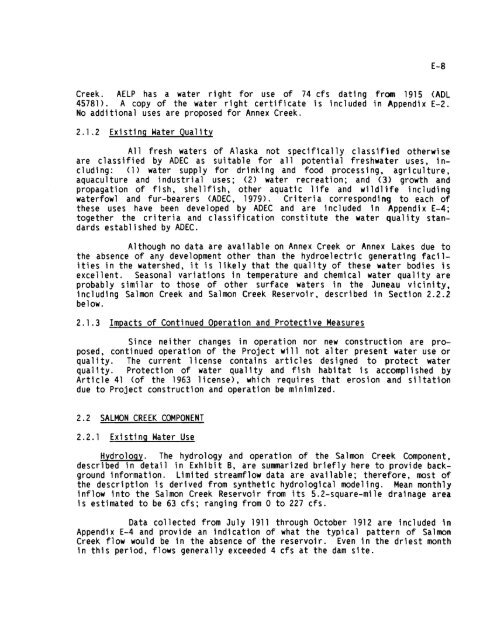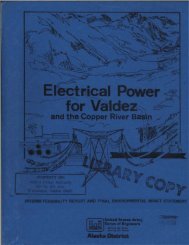Before the FERC Application for New License for the Annex Creek ...
Before the FERC Application for New License for the Annex Creek ...
Before the FERC Application for New License for the Annex Creek ...
Create successful ePaper yourself
Turn your PDF publications into a flip-book with our unique Google optimized e-Paper software.
<strong>Creek</strong>. AELP has a water ri ght <strong>for</strong> use of 74 cfs dati ng from 1915 (ADL<br />
45781). A copy of <strong>the</strong> water right certificate is included 1n Appendix E-2.<br />
No additional uses are proposed <strong>for</strong> <strong>Annex</strong> <strong>Creek</strong>.<br />
2.1.2 Existing Water Quality<br />
All fresh waters of Alaska not specifically classifled o<strong>the</strong>rwise<br />
are classified by ADEC as suitable <strong>for</strong> all potential freshwater uses, including:<br />
(1) water supply <strong>for</strong> drinking and food processing,. agriculture,<br />
aquaculture and industrial uses; (2) water recreation; and (3) growth and<br />
propagation of fish, shellfish, o<strong>the</strong>r aquatic life and wildlife including<br />
waterfowl and fur-bearers (ADEC, 1979). Criteria corresponding to each of<br />
<strong>the</strong>se uses have been developed by ADEC and are included in Appendix E-4;<br />
toge<strong>the</strong>r <strong>the</strong> criteria and classification constitute <strong>the</strong> water quality standards<br />
established by ADEC.<br />
Although no data are available on <strong>Annex</strong> <strong>Creek</strong> or <strong>Annex</strong> Lakes due to<br />
<strong>the</strong> absence of any development o<strong>the</strong>r than <strong>the</strong> hydroelectric generating facilities<br />
in <strong>the</strong> watershed, it is likely that <strong>the</strong> quality of <strong>the</strong>se water bodies is<br />
excellent. Seasonal variations in temperature and chemical water quality are<br />
probably similar to those of o<strong>the</strong>r surface waters in <strong>the</strong> Juneau vicinity,<br />
including Salmon <strong>Creek</strong> and Salmon <strong>Creek</strong> Reservoir, described in Section 2.2.2<br />
below.<br />
2.1.3 Impacts of Continued Operation and Protective Measures<br />
Since nei<strong>the</strong>r changes in operation nor new construction are proposed,<br />
continued operation of <strong>the</strong> Project will not alter present water use or<br />
quality. The current license contains articles designed to protect water<br />
quality. Protection of water quality and fish habitat is accomplished by<br />
Article 41 (of <strong>the</strong> 1963 license), which requires that erosion and siltation<br />
due to Project construction and operation be minimized.<br />
2.2 SALMON CREEK COMPONENT<br />
2.2.1 Existing Water Use<br />
Hydrology. The hydrology and operation of <strong>the</strong> Salmon <strong>Creek</strong>. Component,<br />
described in detail in Exhibit B, are summarized briefly here to provide back.<br />
ground in<strong>for</strong>mation. Limited streamflow data are available; <strong>the</strong>re<strong>for</strong>e, most of<br />
<strong>the</strong> description is derived from syn<strong>the</strong>tic hydrological modeling. Mean monthly<br />
inflow into <strong>the</strong> Salmon <strong>Creek</strong> Reservoir from its 5.2-square-mile drainage area<br />
is estimated to be 63 cfs; ranging from 0 to 227 cfs.<br />
Data collected from July 1911 through October 1912 are included in<br />
Appendix E-4 and provide an indication of what <strong>the</strong> typical pattern of Salmon<br />
<strong>Creek</strong> flow would be in <strong>the</strong> absence of <strong>the</strong> reservoir. Even in <strong>the</strong> driest month<br />
in this period, flows generally exceeded 4 cfs at <strong>the</strong> dam site.<br />
E-8

















